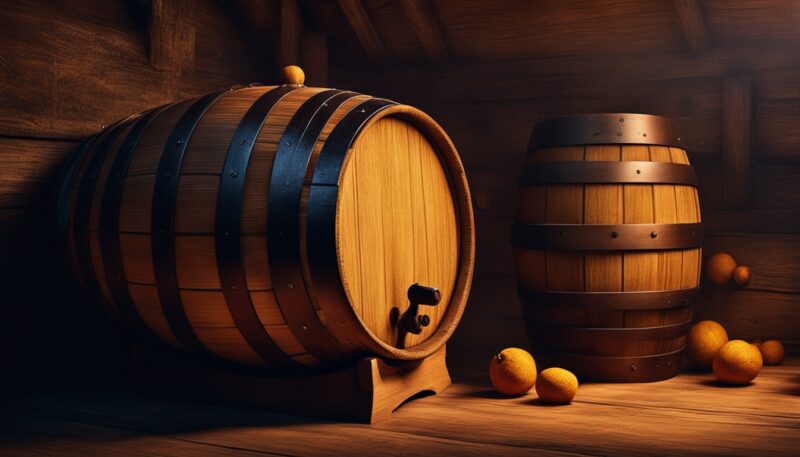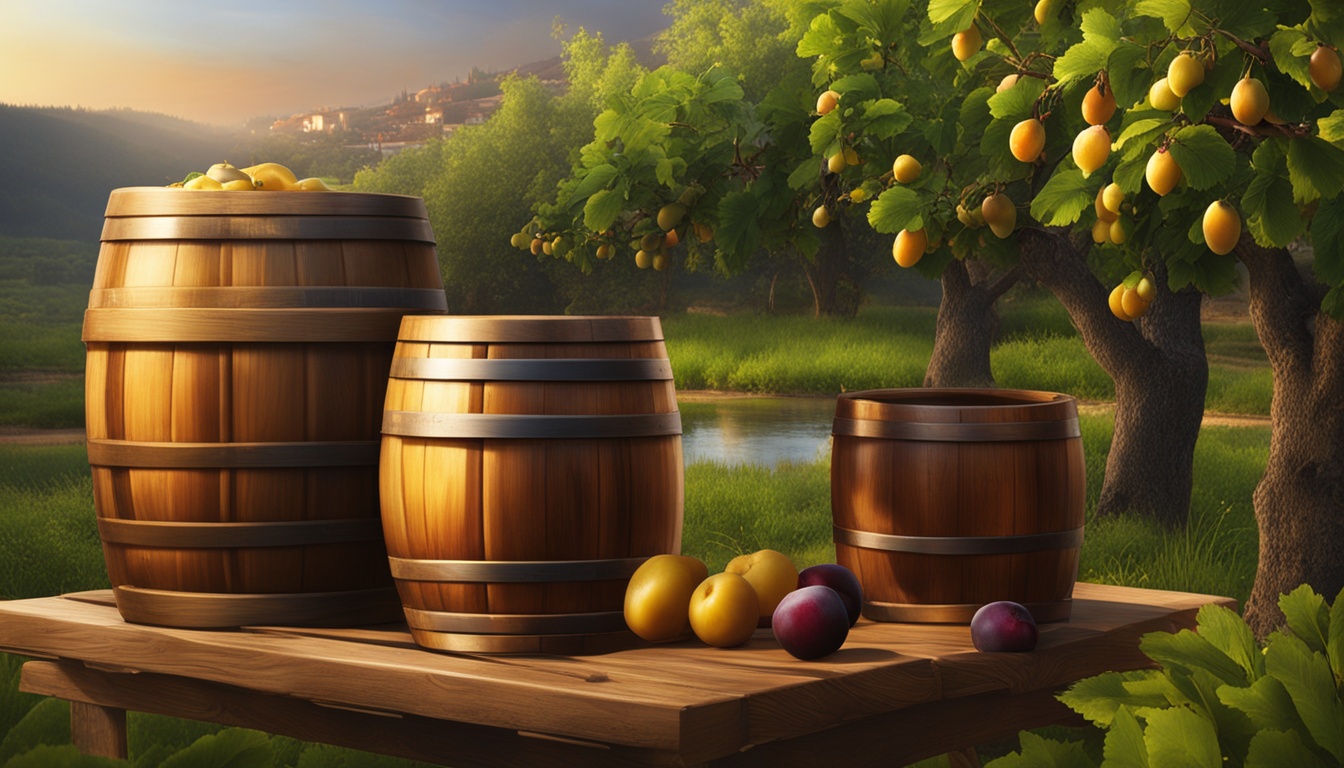Rakija, tradicionalno srpsko piće, zauzima posebno mesto u balkanskoj kulturi. Jedan od ključnih faktora koji utiče na njen kvalitet jeste odabir drveta za odležavanje.
Iako se najčešće koristi hrast, zbog sposobnosti da obogati rakiju složenim aromama, alternativne vrste drveta, poput duda i trešnje, takođe doprinose specifičnim karakteristikama pića.
Bez obzira na to da li se bavite kućnom destilacijom ili komercijalnom proizvodnjom, razumevanje uloge drveta u sazrevanju rakije značajno poboljšava kvalitet krajnjeg proizvoda.
Uloga drveta u proizvodnji rakije

Pravilno korišćenje drveta može obogatiti aromu, poboljšati boju i doprineti složenosti ukusa.
Uticaj na aromu
Vrsta drveta direktno utiče na mirisne note rakije. Na primer, hrast obezbeđuje bogate note vanile i začina, dok dud daje blagu slatkoću, a trešnja voćni i bademasti miris. Takođe, stepen paljenja drveta utiče na finalni miris pića – od blago dimljenih do intenzivno začinjenih nota.
Uticaj na boju
Razvoj boje rakije u velikoj meri zavisi od vrste drveta i načina tretiranja.
Upotreba drvenih komadića ili buradi može ubrzati proces dobijanja bogate i atraktivne boje.
Tradicionalne metode odležavanja u buradima i savremeni pristupi sa čipsom ili kockicama drveta doprinose konzistenciji i intenzitetu boje rakije.
Tradicionalne i savremene metode
Dok tradicionalno odležavanje u buradima ostaje najcenjenija tehnika, savremene metode uključuju upotrebu drvenih komadića i dasaka.
Ove inovacije omogućavaju brži proces sazrevanja i kreiranje specifičnih aroma, što posebno privlači moderne proizvođače rakije.
Takođe, eksperimentisanje sa vrstama hrasta (npr. francuski ili američki hrast) daje različite ukuse i arome.
Poređenje uticaja različitih vrsta drveta
Vrsta drveta
Aroma
Profil ukusa
Preporučene vrste rakije
Hrast (Hrastovo bure)
Blaga, kompleksna
Bogata, zaokružena
Šljiva, loza, dunja
Dud (Dudovo bure)
Suptilna slatkoća
Lagana, drvenasta
Kruška, šljiva
Trešnja (Trešnjino drvo)
Voćna
Slatka, lagana
Voćne rakije (trešnja, višnja)
Koje drvo сe кoristi za odležavanje rakije?
Pravi izbor drveta je presudan za postizanje autentičnog ukusa rakije. Odabir se vrši u skladu sa klimatskim uslovima i vrstom voćne rakije, kako bi se osiguralo najbolje prožimanje ukusa i mirisa.
Hrast (Hrastovo bure)
Sieh dir diesen Beitrag auf Instagram an
Hrast je najpopularniji izbor zbog svoje porozne strukture, koja omogućava kontrolisano sazrevanje rakije.
Hrast daje složene note i blagu aromu vanile, što doprinosi bogatom ukusu.
Tradicionalno se koriste burad od letnjeg i zimskog hrasta, poznatih po svojoj sposobnosti da uskladište i obogate rakiju.
Dud (Dudovo bure)
Dud je popularan kod proizvođača koji žele blaži i slađi profil ukusa. Ovaj tip drveta se često koristi za rakije od šljive i kruške, jer doprinosi suptilnim aromama i poboljšava prirodnu slatkoću pića.
Trešnja (Trešnjino drvo)
@emperus.destilerija Kad kažemo da rakiju od trešnje proizvodimo kao spomen na naše ustanike iz Prvog srpskog ustanka, to je zato što su se u tom periodu iz Srbije u Habzburšku monarhiju najviše izvozile rakije od trešnje, kruške i šljive, a topovi koji su korišćeni za vreme Ustanka bili su upravo od trešnjinog drveta. Da li ste probali EMPERUS rakiju od trešnje? #emperus #destilerija #rakija #sljivovica #najboljasrpskarakija #emperusrakija #emperusdestilerija #destilerijaemperus #sumadijskasljivovica #rakijaodtresnje
Trešnjino drvo dodaje rakiji voćni miris i laganu slatkoću, čineći ga idealnim za odležavanje rakija od trešnje ili drugih voćnih vrsta. Ovaj tip drveta se koristi kod proizvođača koji eksperimentišu sa alternativnim tehnikama sazrevanja.
Poređenje uticaja različitih vrsta drveta
Vrsta drveta
Aroma
Profil ukusa
Preporučene vrste rakije
Hrast (Hrastovo bure)
Blaga, kompleksna
Bogata, zaokružena
Šljiva, loza, dunja
Dud (Dudovo bure)
Suptilna slatkoća
Lagana, drvenasta
Kruška, šljiva
Trešnja (Trešnjino drvo)
Voćna
Slatka, lagana
Voćne rakije (trešnja, višnja)
Zaključak
Odabir drveta za odležavanje rakije igra ključnu ulogu u formiranju njenog ukusa i mirisa.
Tradicionalne metode koriste hrastova burad zbog njihove sposobnosti da dodaju složene arome i boju, dok moderni pristupi uključuju upotrebu drvenih čipsova i kockica kako bi se ubrzao proces sazrevanja.
Kako kućna destilacija postaje sve popularnija, proizvođači sve više eksperimentišu sa različitim vrstama drveta, tražeći savršen balans ukusa i arome.
Bez obzira na to da li ste početnik ili iskusan destiler, razumevanje uloge drveta i pravilan izbor tehnike odležavanja osiguraće da vaša rakija zadrži autentičan karakter i vrhunski kvalitet.

